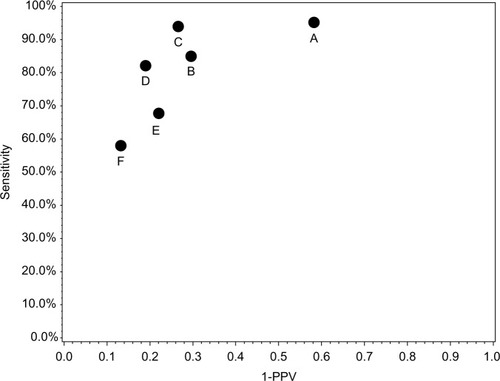Figures & data
Table 1 Algorithms for detection of acute myocardial infarction following percutaneous coronary intervention in the Danish National Patient Registry
Table 2 Baseline characteristics of patients with percutaneous coronary intervention
Figure 1 Sensitivity vs 1-positive predictive value for algorithms A–F.
Abbreviation: PPV, positive predictive value.

Table 3 Performance of algorithms for detection of acute myocardial infarction following percutaneous coronary intervention in the Danish National Patient Registry
Table 4 Performance of algorithm C (all acute admissions with acute myocardial infarction as primary or secondary discharge diagnosis) across subgroups
Table S1 Two-way table for detection algorithm A
Table S2 Two-way table for detection algorithm B
Table S3 Two-way table for detection algorithm C
Table S4 Two-way table for detection algorithm D
Table S5 Two-way table for detection algorithm E
Table S6 Two-way table for detection algorithm F
Table S7 Two-way table for algorithm C stratified for female sex
Table S8 Two-way table for algorithm C stratified for male sex
Table S9 Two-way table for algorithm C stratified for age ≤ 65 years
Table S10 Two-way table for algorithm C stratified for age > 65 years
Table S11 Two-way table for algorithm C stratified for indication of index stent, acute coronary syndrome
Table S12 Two-way table for algorithm C stratified for indication of index stent, stable angina
Table S13 Two-way table for algorithm C stratified on acute myocardial infarction prior to index admission
Table S14 Two-way table for algorithm C stratified on acute myocardial infarction at index admission
Table S15 Two-way table for algorithm C stratified on no prior acute myocardial infarction
Table S16 Two-way table for algorithm C stratified on time from admission, 0–30 days
Table S17 Two-way table for algorithm C stratified on time from admission, >30 days to 1 year
Table S18 Two-way table for algorithm C stratified on time from admission, < 1 year
Table S19 Two-way table for algorithm C stratified on time from admission, 1–2 years
Table S20 Two-way table for algorithm C stratified on time from admission, 2–3 years
Table S21 Two-way table for algorithm C stratified on time from admission, 3–4 years
Table S22 Two-way table for algorithm C stratified on time from admission, 4–5 years
Table S23 Two-way table for algorithm C stratified on time from admission, >30 days to 5 years
